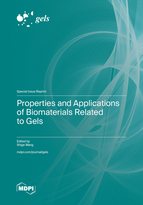Properties and Applications of Biomaterials Related to Gels
A special issue of Gels (ISSN 2310-2861). This special issue belongs to the section "Gel Analysis and Characterization".
Deadline for manuscript submissions: closed (31 July 2023) | Viewed by 25271
Special Issue Editor
Interests: hydrogels; biomaterials; nanoparticles; tissue engineering
Special Issues, Collections and Topics in MDPI journals
Special Issue Information
Dear Colleagues,
As an excellent biopolymer material, gel has been widely used in drug delivery, tissue engineering, disease treatment, etc. By combining different polymers, through physical or chemical changes, the prepared hydrogels can show better performance and be used in various environments.
At present, the exploration of gels in biomedicine seems to be diversified. In order to adapt to the complex environment in the organism, higher requirements must put forward for the gel. Under the premise that the gel is biosafe, it must become tougher or more easily degradable according to the purpose of application, be able stay in the body for a long time to exert its effect, or be easily removed. Moreover, certain gels can even respond to changes in pH, temperature, biological indicators, or microorganisms in the body. We are interested in the intelligent properties of gels, and the condition in which these properties can be used to facilitate their applications is undoubtedly a question that researchers need to consider carefully.
We look forward to your unique insights into gel properties or applications. I hope to share the experimental and research results in this Special Issue and inspire new ideas for gel applications.
Dr. Shige Wang
Guest Editor
Manuscript Submission Information
Manuscripts should be submitted online at www.mdpi.com by registering and logging in to this website. Once you are registered, click here to go to the submission form. Manuscripts can be submitted until the deadline. All submissions that pass pre-check are peer-reviewed. Accepted papers will be published continuously in the journal (as soon as accepted) and will be listed together on the special issue website. Research articles, review articles as well as short communications are invited. For planned papers, a title and short abstract (about 100 words) can be sent to the Editorial Office for announcement on this website.
Submitted manuscripts should not have been published previously, nor be under consideration for publication elsewhere (except conference proceedings papers). All manuscripts are thoroughly refereed through a single-blind peer-review process. A guide for authors and other relevant information for submission of manuscripts is available on the Instructions for Authors page. Gels is an international peer-reviewed open access monthly journal published by MDPI.
Please visit the Instructions for Authors page before submitting a manuscript. The Article Processing Charge (APC) for publication in this open access journal is 2600 CHF (Swiss Francs). Submitted papers should be well formatted and use good English. Authors may use MDPI's English editing service prior to publication or during author revisions.
Keywords
- hydrogel
- hemostasis
- cell cryopreservation
- drug delivery
- wound dressing







